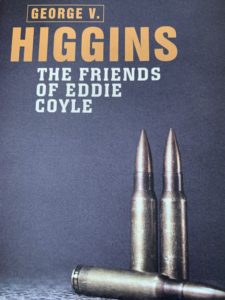My new book Turbulence is published
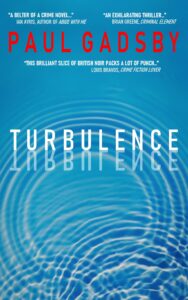
Turbulence, my latest crime novel, has just been published by Fahrenheit Press.
The rippling effects of a violent crime have a devastating impact on six troubled and compelling characters in this multi-viewpoint tale of heartache and hope.
From the offenders and the innocent bystanders to the bank staff and the journalist trying to thread it all together, this book explores how one shocking incident and its turbulent aftermath can connect people from a variety of backgrounds, and how it shapes and haunts them all in different ways.
You can find out more about Turbulence and order the book here. It is available in paperback and ebook (Kindle and ePub). You can also order Turbulence on Amazon here.
Why ‘Graveyard Love’ is such a standout story
I’ve read many good books recently, but one is standing out from the rest of the pack by some distance — Scott Adlerberg’s Graveyard Love.
This intense, atmospheric noir has an innovative and daring premise that is developed with great poise and flair, marking the book out as a different beast to other dark thrillers out there.
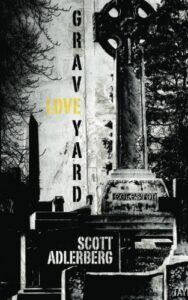
Our narrator, unemployed 35-year-old Kurt Morgan, lives with his mother in her upstate New York home that overlooks a graveyard across the street. He becomes obsessed with an alluring red-haired woman who regularly visits the graveyard at dusk, watching her through a telescope in his room, wondering whose grave she visits like clockwork.
Kurt’s mother, meanwhile, is pressuring him to write her memoir, a project Kurt is disliking more and more with every passing day. Kurt starts following the red-haired woman and discovers she has a lover. A twisted game of paranoia develops between these four characters — Kurt, his mother, the graveyard woman, her lover — with each person pursuing their own twisted motivation at seemingly any cost. Kurt’s obsession turns out to be the strongest, and the most dangerous, as his resentment towards his mother — and his frustration at the cold encounters he has with the red-haired woman — intensifies.
Adlerberg cranks up the pace and tension here, propelling Kurt’s troubled mind into an irrational one as he falls deeper into the stalking vortex. We’re taken down a labyrinth of dark, claustrophobic, and unknown corridors as the author explores the far reaches of the human psyche. Forget the unreliable narrator, this is an insane one. We live with Kurt through every moment, from him approaching the lip of the whirlpool, to teetering over the edge, to falling right in. Disgusted and intrigued at his every move along the way.
The short length of the book (as taut novels tend to do) adds to the drama and imminent sense of danger, creating an unpredictable read amid a growing surge of menace as Kurt grows more unhinged.
Graveyard Love’s masterful breakdown of the warped mind of a main protagonist draws fair comparisons with Robert Bloch’s Psycho, Don DeLillo’s Libra, GBH by Ted Lewis, Marc Behm’s The Eye of the Beholder, and even the works of Alfred Hitchcock and Edgar Allan Poe.
I’d read one of Adlerberg’s books before, the zesty short story collection Dead Guy in the Bathtub, and this novel takes his writing to a new level. Dealing with voyeurism and obsession in such a riveting way, its uneasy, stealthy vibe creates a real sense of personality and represents one of the strongest manipulations of the first-person narrative I’ve come across.
[Top]James Ellroy – always standing above the crowd
 Born on this day in 1948, James Ellroy is possibly the most unique author that modern crime fiction has to offer.
Born on this day in 1948, James Ellroy is possibly the most unique author that modern crime fiction has to offer.
As successful as he is talented, Ellroy’s renowned staccato prose has attracted a deluge of fans and plaudits over the years. The American’s passion for bringing an array of crooked characters – many of them brutally so – to life on the page has seen him produce an exceptional list of books that have been gripping readers for the best part of four decades.
I first came across his work in the early 90s when I was getting into the crime genre. Looking for something at the other end of the spectrum to the cosy mysteries I’d been reading, I spotted on the bookshelves of my local indie a copy of Brown’s Requiem (his debut, published in 1981) and delved in. Boy, was I rewarded. The heavily-clipped writing style immediately appealed; darker and edgier than anything I’d read before, such an unsentimental tone to it, so authoritative, so knowing. He seemed to have a vice-like grip on both his characters’ motivations and how the world worked within a corrupt environment, making the story feel authentic to the core.
There was even better to come. Clandestine and Silent Terror (the latter was also published as Killer on the Road) continued exploiting the same themes of corruption and evil, before Ellroy catapulted to fame with what became known as the ‘LA Quartet’ (The Black Dahlia, The Big Nowhere, LA Confidential, White Jazz from 1987-92). I actually read these out of order first time around as I had difficulty tracking down The Big Nowhere in the pre-digital age, but they all work as cracking standalones.
Many of his works are intrinsically linked to real-life events, most notably the Black Dahlia being a high-profile murder case from 1947. Ellroy also mixed fact with fiction by using various political elements that led up to the JFK hit for his densely-plotted ‘Underworld Trilogy’ of American Tabloid, The Cold Six Thousand and Blood’s a Rover (published between 1995-2009).
The mean streets of post-WW2 Los Angeles have had a huge influence on his life and career, a period of course dripping with noir-esque imagery and nostalgia. The ruthless edge Ellroy brings to his work appears to come from his thirst to depict a variety of dishonest and damaged characters from all walks of life, including elite political circles. Put simply, no one writes about bad guys doing bad things as convincingly as Ellroy.
His tastes for dark scepticism and the callous things in life can also be connected to a traumatic incident in his childhood. When he was 10, his mother, Geneva Hilliker Ellroy, was raped and murdered. The case remains unsolved, despite Ellroy himself teaming up with a retired homicide detective to try and dig up new leads over an intense 15-month period in the 90s – an investigation that he chronicled in the non-fiction book, My Dark Places.
When discussing his own work, Ellroy has never been shy to place himself on the highest of pedestals, often using his media appearances to enforce his reputation as an overpowering presence as well as a hardboiled nihilist. He once said: ‘I am a master of fiction. I am also the greatest crime novelist who ever lived. I am to the crime novel in specific what Tolstoy is to the Russian novel and what Beethoven is to music.’
And also: ‘I’m the demon dog with the hog-log, the foul owl with the death growl, the white knight of the far right, and the slick trick with the donkey dick. I’m the author of 16 books, masterpieces all . . . these books will leave you reamed, steamed and dry-cleaned.’
At 6ft 3in tall, Ellroy naturally comes across as a larger-than-life character, and when he trots out some of the above quotes, he clearly stands out a mile from the more modest, understated approach adopted by many authors in public. But that’s the way it should be with inimitable stylists. His work is different to other crime writers, and it’s fitting that his personality is too. Literature needs a brazen force like James Ellroy.
[Top]Is The Chain worth all the hype?
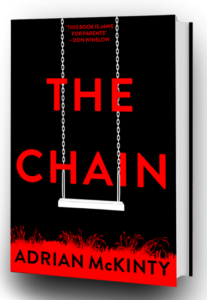 A surge of excitement has been springing from literary circles in the build-up to this summer’s release of Adrian McKinty’s The Chain.
A surge of excitement has been springing from literary circles in the build-up to this summer’s release of Adrian McKinty’s The Chain.
Heavyweight authors such as Stephen King, Don Winslow and Dennis Lehane, together with a deluge of publishing insiders, critics and bloggers, have been waxing lyrical about the novel over the last few months having received their advanced reader copies – so many in fact that I was getting worried for McKinty that there wouldn’t be many readers left to actually buy the book following its release.
Fear not, for the buzz hasn’t stopped since its publication a couple of weeks ago and my purchase is another contribution to the royalty coffers. Readers of this site will know that I am a huge fan of McKinty, loving the rawness and nostalgia that comes from his Sean Duffy series and the brutal noir of his Michael Forsythe trilogy.
The Chain is a departure from his previous work, written more in the style of a commercial thriller to capture a wider scope of readers. The premise in a nutshell: Your phone rings. A stranger has kidnapped your child. To free them you must abduct someone else’s child. Your child will be released when your victim’s parents kidnap another child. If any of these things don’t happen, your child will be killed. You are now part of the chain.
A chilling start, and the best thing about the first half of The Chain is how McKinty’s trademark pace and tempo drives the story along. Rachel O’Neill, a mid-30s divorcee who is recovering from cancer, is the one who gets that dreaded phone call, informing her that her 13-year-old daughter Kylie has been kidnapped. Rachel acquires the support of ex-brother-in-law Pete, an Iraq war vet who has the weaponry and IT software knowledge to help her take on the people behind the chain.
Some reviewers have remarked about McKinty’s shift from crime novel to mainstream thriller here, but I’ve never been a fan of pigeon-holing books into genres that cover such vast material. The crossovers are inevitable. I’ve regarded all McKinty’s novels as ‘thrillers’, in that they are thrilling reads packed with thrilling action, and this work is no different.
It is heavily plot-driven of course, but it doesn’t come at the cost of losing any depth of characterisation. McKinty gives us short bursts of detail that bring the protagonists to life, that sharpen the edges. This is especially the case in the second half of the book that delves into the backstory of how the concept of the chain was formed and the people behind it. Although I won’t give much away for fear of spoilers, it is these darker elements to the story that really give the book that punchy, visceral McKinty feel.
The plot is reliant on several parents from a non-criminal background taking on, in turn, a string of unfamiliar and life-threatening tasks. Scouting and prepping a suitable hideaway, planning and successfully carrying out the ruthless kidnapping of a child, becoming proficient in the use of firearms, hiding evidence of their identities in all communications, covering their tracks physically and digitally, convincingly threatening the next parent in the chain, etc. In the hands of some authors, this might come across as slightly implausible, but McKinty is a safe pair of hands. His years of quality writing experience allow him to paint a vivid picture of what motivates his characters, in this case demonstrating that the besieged parents, suffering from the gut-wrenching pain of having their child taken from them, are driven by that very despair – and the guilt they will have to live with if they don’t pull this off – to stoop to whatever level is necessary to get their child back. A primeval force takes over.
As Rachel herself surmises: ‘Even an imbecile knows you don’t get between a grizzly-bear mama and her cub’
The Chain is a breath-taking read worthy of the hype surrounding it and no writer deserves the success more than McKinty (Paramount have already bought the film rights in a seven-figure deal). In recent interviews McKinty has revealed that – despite the critical acclaim and awards that his backlist has received – he was on the verge of quitting writing due to a lack of monetary return. This came as a surprise to me as I was under the impression that his standing as one of the top British crime writers meant he was doing pretty well earnings wise.
It says a lot about the state of the current publishing industry that such a talented and relatively high-profile author, whose books received coverage in the national press, was struggling to earn a living from the trade. No wonder he wanted to go down the route of producing a more commercially-orientated standalone – and thankfully it’s a belter.
[Top]Some of the hottest new reads out there right now
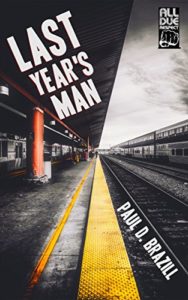 Aside from the day job and promoting my noir thriller Back Door to Hell in recent months, I’ve still been finding time – as always – to read some riveting books.
Aside from the day job and promoting my noir thriller Back Door to Hell in recent months, I’ve still been finding time – as always – to read some riveting books.
So to give you a flavour of what I’d recommend at the cutting edge of contemporary crime fiction, below are some reviews I’ve posted for some of my favourite reads of 2019 so far…
Last Year’s Man, by Paul D. Brazill
I’ve always been fascinated by the ageing gangster/hitman theme and this slick and stylish noir thriller from Paul D. Brazill is a barnstorming success.
Tommy Bennett, feeling heat from the London law after a botched job, returns to his native north east (a nice nod to Get Carter) to lay low and regroup. But reconnecting with old underground acquaintances and family members is no easy thing, nor is dealing with a weakening bladder and increasing medication routines, and Tommy needs to show all his grit and resourcefulness to steer clear of dangerous old ghosts haunting him.
Structured within an easily digestible novella length, this is a breezy tale filled with Brazill’s familiar sharp, clipped dialogue. There are plenty of laugh-out-loud one-liners, while the cultural references are relevant and the violence is vivid. The free-flowing narrative makes this a really enjoyable read and a standout addition to this author’s extremely credible back catalogue.
Dread: The Art of Serial Killing, by Mark Ramsden
This smart, sharply observed thriller is a thoroughly entertaining and rewarding read.
Few main protagonists are as entrancing and depraved as the Dickens-obsessed Madden, a spy and a serial killer who’s spinning more than a few plates as he infiltrates a right-wing nationalist group.
Aside from the charismatic and twisted hero/anti-hero, the prose style is a real highlight to this book. Shifting in tone from despair to graphic with a slick rhythm and a healthy dose of perfectly pitched dark humour throughout, the author is effortlessly in control of where he’s steering you.
The tempo and style reminded me of the brutal yet eloquent noir of Matthew Stokoe in places. This is a read that you won’t forget in a hurry – highly recommended.
Townies: And Other Stories of Southern Mischief, by Eryk Pruitt
I love short story collections and I’ve come across some of Eryk Pruitt’s writing in a few crime anthologies, but this was my first experience of a whole book of his work.
His range is impressive – in terms of subject matter, characters and setting – and there’s something here for every fiction fan, from a humorous take on a vengeful tale about profiting via fantasy football to a cruel battle over a lawn mowing route.
The dialogue in every story is convincing and the themes explored – whether it’s violence, the threat of violence, desperation or redemption – are delivered with care an aplomb. Lots of showing not telling, lots of brutality and second guessing, this author has a lot of control over his writing and the stories had me entertained and, in some cases, spellbound.
Dead is Beautiful, by Jo Perry
The Charlie and Rose series has captured the hearts and imagination of many readers, and with this latest instalment it’s easy to see why.
Charlie and his ghostly canine companion Rose, both dead and existing in a surreal afterlife, return to LA in this new mystery crammed with hardened prose, dry humour, and of course dark, dark noir.
A mature tree is felled illegally, throwing the two protagonists into an investigation that leads to a murder and into the path of Charlie’s brother, who’s in danger and needs help. Charlie, who never got on with his sibling, is trapped in a state of melancholy for much of this tale and needs the good-natured and perceptive Rose by his side more than ever if he’s going to power through.
Exploring the city’s homelessness as well as its luxury mansions, this book has great range of setting and character. The profound tone of the story is complemented by the brusque writing style and existential backdrop, all played out with a shrewd, ironic edge.
Fahrenheit Press deserve great praise for putting their faith in this brave and accomplished series. ‘The coolest collection of hardboiled and experimental crime fiction on the planet’ is the blurb of imprint Fahrenheit 13 – on this evidence, that claim is being fulfilled in spades.
Death of an Angel, by Derek Farrell
Danny Bird’s fourth adventure, this book is woven with a delightfully smooth and engaging writing style that really hooks you in from the start.
The stakes are high for the main protagonist, a bar manager/amateur sleuth, as he attempts to solve a multi-layered mystery that is intricately plotted and laced with polished humour. Danny’s exploits see him exposed to a wide range of characters and settings, up against high-powered corruption as well as domestic and personal strife.
The prose has a gorgeous, warm flow to it that particularly appealed to me, while the story is skilfully structured as it builds to a fitting crescendo.
Like all good series books, Death of an Angel also works as a standalone, with the various twists and turns – all driven from, or towards, the heart of the main character – unravelled with masterful elegance.
Broken Dreams, by Nick Quantrill
Down-at-heel PI Joe Geraghty, scraping a living in the northern, isolated city of Hull, is hired by a local businessman to investigate a staff member’s unexplained absenteeism. The case soon leads Geraghty into the heart of a murder investigation that carries links to Frank Salford, a key businessman central to the city’s regeneration scheme who is also a ruthless gangland boss.
The pace of this book is strong from the start and the drama heightens nicely as the story unfolds and the stakes rise. Geraghty is a very well-drawn character, the naturalness of his mannerisms, behaviour, outlook and dialogue really flesh out the believability factor in him. So many authors try to make their characters appear real by homing in on their ‘normal’ qualities to make them likeable and it can feel too contrived, but everything about Geraghty – the good and the bad – comes across as authentic in an effortless way.
But there’s another major character that deserves a mention here – Hull itself. Reading the book from the perspective of someone who has never been there but has felt enriched by visiting many northern cities, including living in one for four years, I felt this was a real bonus in Broken Dreams. Getting to know the many parts of Hull, from its past as a fishing fortress to its modern-day cultural renaissance, and feeling its gritty core and warm soul contributes significantly to the success of this urban tour-de-force.
[Top]10 thrilling cat-and-mouse chases
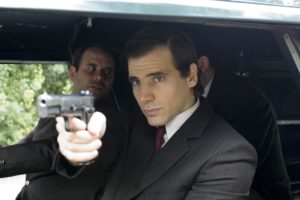 I recently wrote an article for the Criminal Element website about my favourite fictional chase sequences that helped inspire my new novel Back Door to Hell.
I recently wrote an article for the Criminal Element website about my favourite fictional chase sequences that helped inspire my new novel Back Door to Hell.
The piece, titled ‘The best cat-and-mouse chase thrillers in crime fiction’, explores 10 examples of captivating stories – ranging from the classic to the modern – that feature a significant chase as part of the plot, from police pursuing criminals to villains hunting after each other.
Take a look and let me know at @PaulJGadsby if you think I’ve missed any crackers out.
[Top]Back Door to Hell now on sale
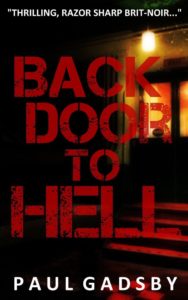 My new noir thriller Back Door to Hell has just been released by Fahrenheit 13.
My new noir thriller Back Door to Hell has just been released by Fahrenheit 13.
The publisher of the coolest collection of hard-boiled noir and experimental crime fiction on the planet (their words, but independently verified by several sources as absolutely true) publishes a new book on the 13th of every month, and January 2019 is the turn of my second full-length novel.
Back Door to Hell is a lean and pacey thriller that follows a young couple on the run after they steal a shedload of cash from a South London underworld crime boss.
More details about Back Door to Hell can be found here, while you can order or download the book direct from Fahrenheit 13 here or alternatively from Amazon on Kindle here and on paperback here.
It’s available at a fantastic price as well, from just £1.69 on ebook and £8.95 on paperback as a special new-release offer – so get in quick while the generosity lasts.
[Top]Don DeLillo’s Libra – 30 years on
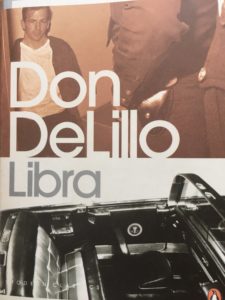 This month marks the 30th anniversary of the release of what I regard as the most powerful book ever written about the JFK assassination – Libra by Don DeLillo.
This month marks the 30th anniversary of the release of what I regard as the most powerful book ever written about the JFK assassination – Libra by Don DeLillo.
Released on 15 August 1988, this extraordinary novel blends historical fact and fictional speculation to offer a mesmerising account of the infamous murder of President John F. Kennedy in his motorcade in downtown Dallas 1963. The tale is told purely from the perspective of the man predominantly – and officially at least – held responsible for the killing: Lee Harvey Oswald.
Whether Oswald was the lone assassin is still open to fierce dispute, with many ballistics experts, historians and witnesses still offering to this day conflicting accounts of what transpired during that fateful November lunchtime.
Despite the government-backed Warren Commission report concluding that Oswald acted alone in firing three shots from his rifle from the sixth floor of the Texas Schoolbook Depository, there is no universal consensus on several details. The number of gunmen involved, the calibre of the weaponry used, the quantity of rounds fired and from which location(s), as well as the overriding motive, are all still up for debate.
In Libra (the title being Oswald’s astrological sign), DeLillo explores what he regards as the most likely possibility: that the hit was instigated by disgruntled CIA operatives carrying deep anti-Castro ideology that Kennedy was failing to prioritise. In this version of events Oswald’s shots were – unbeknown to him – supplemented by more deft marksmanship from the grassy knoll, a controversial spot many have claimed to be the most realistic source of the fatal headshot captured so vividly and brutally in the Zapruder film.
“I could perhaps have written the same book with a completely different assassination scenario,” DeLillo said in a Rolling Stone interview in 1991.
But the technical details of the hit are not why people should read this book. They should read it for DeLillo’s unflinching yet visceral depiction of Oswald’s painful and pitiful journey.
Starting with a haunting scene of him riding the subway through the Bronx during a turbulent two-year stay in New York in his early teens, we get an immediate sense of this misfit searching for meaning. Standing pressed against the window taking the curves, jerks and pushes of the train, he finds that the drunks, pickpockets and dark tunnels of the bowels beneath the city hold more allure for him than the glittering streets above. It’s so real you feel you can almost reach out and touch him.
The book follows Oswald’s adolescent years followed by a failed stint in the US Marine Corps, an ultimately failed defection to the old Soviet Union and his violent marriage. Then it cranks up, covering his desperate but fruitless struggle to leverage his passionate communist views into a position of authority within high-ranking pro-red social circles on his return to the USA.
DeLillo skilfully paints a picture of this vivid outcast – intellectually, socially, physically and emotionally – as he constantly strives to find his place, to earn the respect he craves.
There is no effort to portray Oswald sympathetically, or even critically. He is carved open and exposed for readers to draw their own conclusions of the man as the narrative weaves towards Dealey Plaza. The internal conflicts and self-contradictions Oswald battles with pull him closer to the surface, sharpening the hazy sketches of his personality provided by numerous documentaries.
We learn that Oswald loves his young Russian wife yet hits her, he would do anything for his children but hatches a plan that draws him away from their clutches. He is well-read but dyslexic, he is thoughtful yet not smart, he is driven but also confused.
No one has analysed the complex and infuriating character that is Oswald through such a deep lens. The inner intensity of Oswald’s escape from the depository, his subsequent shooting of a police officer in the street and his arrest in a nearby cinema, and his final hours that follow is gloriously seamless and utterly compelling.
Libra won The Irish Times’ first International Fiction Prize and, three decades on, is still a classic example of how to get under the skin of a multi-layered persona in the public eye and truly dissect every sense of their being.
[Top]
